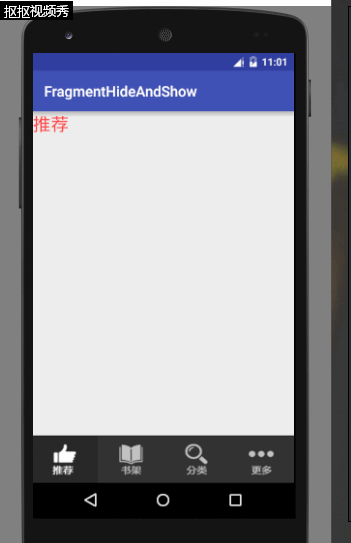我们都知道,Fragment动态添加的时候我们可以使用FragmentTransaction的add和replace方法,replace方法就等效于对这个Fragment先执行remove(),再执行add()。但是在实际的项目中,有很多时候我们会用到底部是一个RadioGroup包裹的RadioButton,上面用Fragment的情况,因为我们是从网络上获取的数据,这种时候我们不希望点击加载过的页面(也就是加载过的Fragment)的时候,每次都重新加载。也就是使用FragmentTransaction#replace()或者是add()方法行不通了,影响用户体验,这个时候就要用到FragmentTracsaction中的另两个方法了,也就是今天要提到的hide()和show()方法。这两个方法简单地说是会隐藏指定的Fragment,并不会销毁此Fragment,所以也就是可以保存下来之前在此Fragment中加载的数据了~。下面来看一下这个Demo吧:
我们要实现的就是这样一个效果:

其实不在网络上加载数据的话看不出来什么具体的效果,不过我们还是先看一下代码吧:
主页面的布局如下:
1 <?xml version="1.0" encoding="utf-8"?> 2 <LinearLayout xmlns:android="http://schemas.android.com/apk/res/android" 3 android:layout_width="match_parent" 4 android:layout_height="match_parent" 5 android:orientation="vertical" 6 > 7 8 <LinearLayout 9 android:id="@+id/layout_main_fragment" 10 android:layout_weight="1" 11 android:layout_width="match_parent" 12 android:layout_height="0dp" 13 android:orientation="vertical"> 14 15 </LinearLayout> 16 17 <RadioGroup 18 android:id="@+id/rg" 19 android:layout_width="match_parent" 20 android:layout_height="wrap_content" 21 android:gravity="center" 22 android:layout_alignParentBottom="true" 23 android:orientation="horizontal"> 24 25 <RadioButton 26 android:id="@+id/rb_tj" 27 android:layout_width="0dp" 28 android:layout_height="65dp" 29 android:layout_weight="1" 30 android:background="@drawable/rb_tuijian" 31 android:button="@null" 32 android:checked="true" /> 33 34 <RadioButton 35 android:id="@+id/rb_sj" 36 android:layout_width="0dp" 37 android:layout_height="65dp" 38 android:layout_weight="1" 39 android:background="@drawable/rb_shujia" 40 android:button="@null" /> 41 42 <RadioButton 43 android:id="@+id/rb_fl" 44 android:layout_width="0dp" 45 android:layout_height="65dp" 46 android:layout_weight="1" 47 android:background="@drawable/rb_fenlei" 48 android:button="@null" /> 49 50 <RadioButton 51 android:id="@+id/rb_gd" 52 android:layout_width="0dp" 53 android:layout_height="65dp" 54 android:layout_weight="1" 55 android:background="@drawable/rb_gengduo" 56 android:button="@null" /> 57 </RadioGroup> 58 </LinearLayout>
这里用到了四个selector选择器作为RadioButton的背景,其他的没有什么,很简单的布局。当然,为了展示,我们还需要一个Fragment以及其对应的布局:
1 <?xml version="1.0" encoding="utf-8"?> 2 <LinearLayout xmlns:android="http://schemas.android.com/apk/res/android" 3 android:layout_width="match_parent" 4 android:layout_height="match_parent" 5 android:orientation="vertical"> 6 <TextView 7 android:id="@+id/tv" 8 android:layout_width="wrap_content" 9 android:layout_height="wrap_content" 10 android:textSize="25sp" 11 android:textColor="@android:color/holo_red_light" 12 android:text="哈哈哈"/> 13 </LinearLayout>
由于只是一个小Demo,这里就没有写多个Fragment,而是复用了这一个Fragment,通过Fragment#setArgument(Bundle bundle)方法和getArgument()方法来复用该Fragment:
1 package ggcomic.rabbit.lx.fragmenthideandshow.fragment; 2 3 import android.os.Bundle; 4 import android.support.annotation.Nullable; 5 import android.support.v4.app.Fragment; 6 import android.view.LayoutInflater; 7 import android.view.View; 8 import android.view.ViewGroup; 9 import android.widget.TextView; 10 11 import ggcomic.rabbit.lx.fragmenthideandshow.R; 12 13 /** 14 * Created by Lx on 2016/9/20. 15 */ 16 public class MyFragment extends Fragment { 17 18 private TextView tv; 19 20 @Nullable 21 @Override 22 public View onCreateView(LayoutInflater inflater, @Nullable ViewGroup container, @Nullable Bundle savedInstanceState) { 23 View view = inflater.inflate(R.layout.fragment_page, null); 24 tv = (TextView) view.findViewById(R.id.tv); 25 Bundle bundle = getArguments(); 26 int tag = bundle.getInt("tag"); 27 switch (tag) { 28 case 1: 29 tv.setText("推荐"); 30 break; 31 case 2: 32 tv.setText("书架"); 33 break; 34 case 3: 35 tv.setText("分类"); 36 break; 37 case 4: 38 tv.setText("更多"); 39 break; 40 } 41 return view; 42 } 43 }
最主要的就是在MainActivity中的处理:
1 package ggcomic.rabbit.lx.fragmenthideandshow.main; 2 3 import android.support.v4.app.Fragment; 4 import android.support.v4.app.FragmentManager; 5 import android.support.v4.app.FragmentTransaction; 6 import android.support.v7.app.AppCompatActivity; 7 import android.os.Bundle; 8 import android.view.View; 9 import android.widget.LinearLayout; 10 import android.widget.RadioButton; 11 12 import ggcomic.rabbit.lx.fragmenthideandshow.R; 13 import ggcomic.rabbit.lx.fragmenthideandshow.fragment.MyFragment; 14 15 public class MainActivity extends AppCompatActivity implements View.OnClickListener { 16 17 private Fragment currentFragment=new Fragment(); 18 private LinearLayout layout; 19 private RadioButton rb_tj,rb_sj,rb_fl, rb_gd; 20 private Fragment fragment_tj,fragment_sj,fragment_fl, fragment_gd; 21 private FragmentManager manager; 22 23 @Override 24 protected void onCreate(Bundle savedInstanceState) { 25 super.onCreate(savedInstanceState); 26 setContentView(R.layout.activity_main); 27 initView(); 28 initFragment(); 29 initEvent(); 30 showFragment(fragment_tj); 31 } 32 33 /** 34 * 初始化监听 35 */ 36 private void initEvent() { 37 rb_tj.setOnClickListener(this); 38 rb_sj.setOnClickListener(this); 39 rb_fl.setOnClickListener(this); 40 rb_gd.setOnClickListener(this); 41 } 42 43 /** 44 * 初始化Fragment 45 */ 46 private void initFragment() { 47 manager = getSupportFragmentManager(); 48 49 Bundle bundle = new Bundle(); 50 bundle.putInt("tag", 1); 51 fragment_tj = new MyFragment(); 52 fragment_tj.setArguments(bundle); 53 54 bundle = new Bundle(); 55 bundle.putInt("tag", 2); 56 fragment_sj = new MyFragment(); 57 fragment_sj.setArguments(bundle); 58 59 bundle = new Bundle(); 60 bundle.putInt("tag", 3); 61 fragment_fl = new MyFragment(); 62 fragment_fl.setArguments(bundle); 63 64 bundle = new Bundle(); 65 bundle.putInt("tag", 4); 66 fragment_gd = new MyFragment(); 67 fragment_gd.setArguments(bundle); 68 } 69 70 /** 71 * 展示Fragment 72 */ 73 private void showFragment(Fragment fragment) { 74 if (currentFragment!=fragment) { 75 FragmentTransaction transaction = manager.beginTransaction(); 76 transaction.hide(currentFragment); 77 currentFragment = fragment; 78 if (!fragment.isAdded()) { 79 transaction.add(R.id.layout_main_fragment, fragment).show(fragment).commit(); 80 } else { 81 transaction.show(fragment).commit(); 82 } 83 } 84 } 85 86 /** 87 * 初始化控件 88 */ 89 private void initView() { 90 rb_tj = (RadioButton) findViewById(R.id.rb_tj); 91 rb_sj = (RadioButton) findViewById(R.id.rb_sj); 92 rb_fl = (RadioButton) findViewById(R.id.rb_fl); 93 rb_gd = (RadioButton) findViewById(R.id.rb_gd); 94 } 95 96 @Override 97 public void onClick(View v) { 98 switch (v.getId()) { 99 case R.id.rb_tj: 100 showFragment(fragment_tj); 101 break; 102 case R.id.rb_sj: 103 showFragment(fragment_sj); 104 break; 105 case R.id.rb_fl: 106 showFragment(fragment_fl); 107 break; 108 case R.id.rb_gd: 109 showFragment(fragment_gd); 110 break; 111 } 112 } 113 }
可以看到,我们定义了一个全局Fragment,currentFragment,用来标示当前是哪一个Fragment。其中initFragment()方法只是为了初始化所有的Fragment,相信大家也看得出来,最主要的方法是showFragment(),下面我就来说一下这个方法:
1 /** 2 71 * 展示Fragment 3 72 */ 4 73 private void showFragment(Fragment fragment) { 5 74 if (currentFragment!=fragment) { 6 75 FragmentTransaction transaction = manager.beginTransaction(); 7 76 transaction.hide(currentFragment); 8 77 currentFragment = fragment; 9 78 if (!fragment.isAdded()) { 10 79 transaction.add(R.id.layout_main_fragment, fragment).show(fragment).commit(); 11 80 } else { 12 81 transaction.show(fragment).commit(); 13 82 } 14 83 } 15 84 }
这个方法主要完成Fragment的隐藏和展示,也就是完成Fragment的切换功能。可以看到,在方法的开始我们先判断一下传入的Fragment是不是当前currentFragment,如果不是的话,我们就隐藏currentFragment,并且将我们传入的Fragment赋值给currentFragment。然后再调用Fragment#isAdded()方法,判断传入的Fragment是否已经被add()过了,如果已经被add()过了,那么就直接FragmentTransaction#show()并且commit()即可,否则的话先add()当前fragment,然后在show()展示出来。这样我们就成功实现了保存加载过的Fragment中的内容了(其实不算保存,只是不让加载过的内容销毁),是不是很简单呢?快下一个小Demo尝试一下吧~